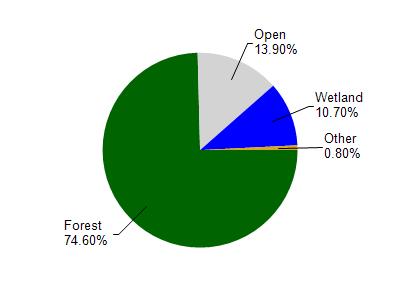Vilas
No
No
Yes
Fish and Aquatic Life
Overview
, in the St. Germain River Watershed, is a 336.35 acre lake that falls in Vilas County. This lake is managed for fishing and swimming and is currently not considered impaired.
Date 2011
Author Aquatic Biologist
Historical Description
Source: 1963, Surface Water Resources of Vilas County
Found Lake, T-40-N, R-8-E, Sections 13 and 14,
Area = 326 Surface Acres, Maximum Depth = 20 feet
Found Lake is a drainage lake of moderate fertility. It has
clear, slightly alkaline water of low to moderate transparency with
readings depending upon the algal response to the lake's fertility.
Bottom materials consist predominantly of sand, with gravel, rock
and muck also present. The muskellunge and the walleye are
considered to be the principal fish species; however, large and
smallmouth bass as well as pan fish are also present. At present
there is no public access to Found Lake. Public use facilities
consist of eight resorts with possible boat rental facilities.
There is also one trailer camp and one youth camp. There are 26
cottages or dwellings on or resorts about the shore line.
Muskrats are considered to be a significant fur bearer on this
lake.
Date 1963
Author Surface Water Inventory Of Wisconsin
Condition
Wisconsin has over 84,000 miles of streams, 15,000 lakes and milllions of acres of wetlands. Assessing the condition of this vast amount of water is challenging. The state's water monitoring program uses a media-based, cross-program approach to analyze water condition. An updated monitoring strategy (2015-2020) is now available. Compliance with Clean Water Act fishable, swimmable standards are located in the Executive Summary of Water Condition in 2018. See also the 'monitoring and projects' tab.
Reports
Recommendations
County Land and Water Management Plan
Town of St. Germain proposes an extensive land and water resource protection program that includes the areas in and around Big and Little St. Germain, Lost Lake and other area water resources. This project will be a broad based long term cooperative planning effort involving the St. Germain Planning Committee, town officials, UW-Extension office and concerned citizens.
Monitor Wildlife
Restore Riparian Habitat
Found Lake Shoreline Restoration
Management Goals
Wisconsin's Water Quality Standards provide qualitative and quantitative goals for waters that are protective of Fishable, Swimmable conditions [Learn more]. Waters that do not meet water quality standards are considered impaired and restoration actions are planned and carried out until the water is once again fishable and swimmable
Management goals can include creation or implementation of a Total Maximum Daily Load analysis, a Nine Key Element Plan, or other restoration work, education and outreach and more. If specific recommendations exist for this water, they will be displayed below online.
Monitoring
Monitoring the condition of a river, stream, or lake includes gathering physical, chemical, biological, and habitat data. Comprehensive studies often gather all these parameters in great detail, while lighter assessment events will involve sampling physical, chemical and biological data such as macroinvertebrates. Aquatic macroinvertebrates and fish communities integrate watershed or catchment condition, providing great insight into overall ecosystem health. Chemical and habitat parameters tell researchers more about human induced problems including contaminated runoff, point source dischargers, or habitat issues that foster or limit the potential of aquatic communities to thrive in a given area. Wisconsin's Water Monitoring Strategy was recenty updated.
Grants and Management Projects
Monitoring Projects
| WBIC | Official Waterbody Name | Station ID | Station Name | Earliest Fieldwork Date | Latest Fieldwork Date | View Station | View Data |
|---|
| 1593800 | Found Lake | 10033920 | Found Lake -- Private Access at Southern Tip (Gensler Trailer Park) | 6/10/2011 | 6/10/2011 | Map | Data |
| 1593800 | Found Lake | 10005968 | Found Lake | 5/13/1996 | 6/21/2018 | Map | Data |
| 1593800 | Found Lake | 10033922 | Found Lake -- Private Access at the Southern Tip (Heck Court) | 6/11/2011 | 6/11/2011 | Map | Data |
| 1593800 | Found Lake | 643482 | Found Lake - SW Site | 9/6/1996 | 10/3/2025 | Map | Data |
| 1593800 | Found Lake | 10030426 | Found Lake -- Landing at Gensler's Trailer Park (off Juve Rd) | 5/1/2009 | 7/3/2011 | Map | Data |
| 1593800 | Found Lake | 10018747 | Found Lake -- Access at SE side of lake (off Kleppe Rd) | 5/31/2005 | 10/13/2025 | Map | Data |
| 1593800 | Found Lake | 643065 | Found Lake - Deep Hole-East | 7/23/1979 | 8/24/2025 | Map | Data |
|

Watershed Characteristics
Found Lake is located in the St. Germain River watershed which is 70.11 mi². Land use in the watershed is primarily forest (74.60%), open (13.90%) and a mix of wetland (10.70%) and other uses (0.80%). This watershed has 39.57 stream miles, 3,101.31 lake acres and 5,357.65 wetland acres.
Nonpoint Source Characteristics
This watershed is ranked Not Ranked for runoff impacts on streams, Medium for runoff impacts on lakes and Low for runoff impacts on groundwater and therefore has an overall rank of Low. This value can be used in ranking the watershed or individual waterbodies for grant funding under state and county programs.However, all waters are affected by diffuse pollutant sources regardless of initial water quality. Applications for specific runoff projects under state or county grant programs may be pursued. For more information, go to surface water program grants.